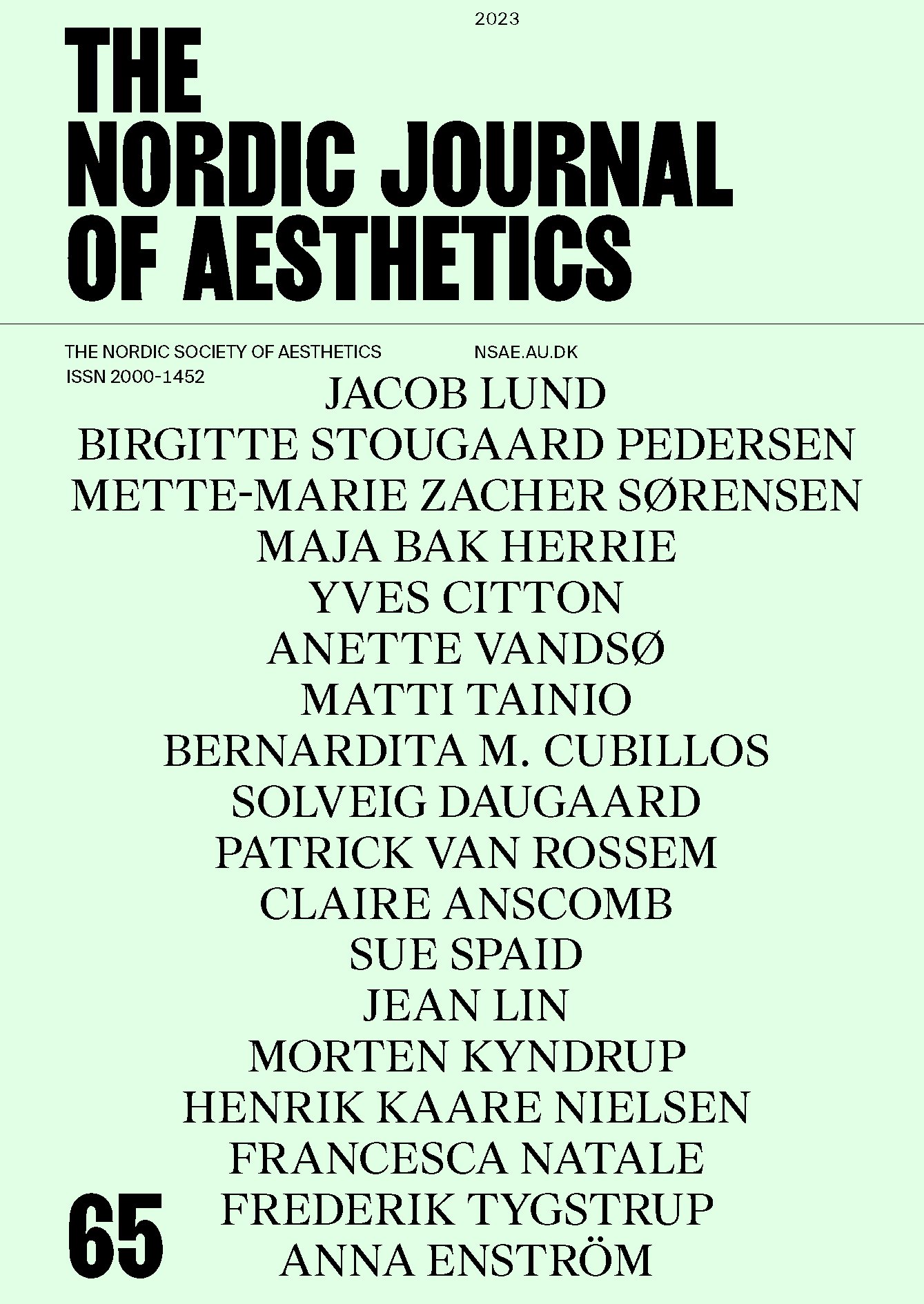Silence! The Background of Attention as a Battleground
DOI:
https://doi.org/10.7146/nja.v32i65-66.140098Keywords:
Silence, Attention Ecology, John Cage, Background Soundings, Attention EconomyAbstract
The commodification of silence responding to a disturbing environment is integrated in the growing attention economy. This paper suggests that the idea of silence embedded in these products preclude fruitful understandings of—and interventions in—the
problematics they address, and it proposes Cage’s silence as a more efficacious model for understanding our problems with a disturbing environment, and a better practice for intervening in it. Informed by Yves Citton’s ecology of attention the paper argues that Cage’s silence centers the interplay of attention, subjectivity and intentionality, as it takes play between us and the background, which to some extent produces us. And finally, it suggests that the Cagean practice of paying attention to this background is what Citton calls a “micropolitics of attention”, because it reveals the background as a battleground.
References
Karin Bijsterveld, Mechanical Sound Technology, Culture, and Public Problems of Noise in the Twentieth Century (Cambridge, MA: MIT Press, 2008).
John Cage, Silence (New York: Marion Boyars, 2004).
John Cage, 4’33’’(Tacet Version) For Any Instrument or Combination of Instruments (Edition Peters, 1960).
John Cage “A Composer’s Confessions (1948),” in Richard Kostelanetz (ed.), John Cage, Writer: Selected Texts (New York: Cooper Square Press, 2000).
Yves Citton, “Automatizing Attention vs. A Public Right to Hear,” keynote at The Aesthetics of Attention, annual conference of the Nordic Society of Aesthetics, 2021.
Yves Citton, The Ecology of Attention (Cambridge: Polity Press, 2017).
Nicholas Cook, Music, Imagination & Culture (Oxford: Oxford University Press, 1992).
Thomas Davenport and John Beck, The Attention Economy: Understanding the New Currency of Business (Cambridge, MA: Harvard Business School Press, 2001).
Kyle Gann, No Such Thing as Silence, (London: Yale University Press, 2010).
Matthew F. Jordan, “Canned Music and Captive Audiences. The Battle Over Public Soundspace at Grand Central Terminal and the Emergence of the New Sound”, The Communication Review, 17 (2014) 286–310. DOI: 10.1080/10714421.2014.960734.
Douglas Kahn, Noise Water Meat: A History of Sound in the Arts (Cambridge, MA: MIT Press, 2001).
Anahid Kassabian, Ubiquitous Listening: Affect, Attention, and Distributed Subjectivity, (Berkeley and London: University of California Press, 2013).
Richard Kostelanetz, “In his own words”, Perspectives on New Music, Vol, 25, no.1–2 (1987).
Joseph Lanza, Elevator Music: A Surreal History of Muzak, Easy-Listening, and Other Moodsongs (London: St. Martin’s Press, 1994).
Jacob Lund, “Artistic Re-Appropriation and Reconfiguration of the Medium’s Milieu,” Nordic Journal of Aesthetics, no. 44–45 (2013).
John Picker, “The Soundproof Study,” in Jonathan Sterne (ed.), The Sound Studies Reader (New York: Routledge, 2012).
Hannah Pivo, “Selling Silence, Controlling Chaos: John Cage’s Interventions into Muzak,” Public Art Dialogue, 9:1 (2016): 97. DOI: 10.1080/21502552.2019.1571842.
Alexander Russo, “An American Right to an ‘Unannoyed Journey’? Transit Radio as a Contested Site of Public Space and Private Attention, 1949–1952.” Historical Journal of Film, Radio & Television, Vol. 29 Issue 1 (March 2009) 1–25. DOI 10.1080/01439680802704575.
Sabine Sanio, Alternativen zur werkästhetik. John Cage und Helmut Heissenbüttel (Saarbrücken: Pfau,1999).
Murray R. Schafer, The Soundscape: Our Sonic Environment and the Tuning of the World (Rochester: Destiny Books, 1997).
Martin Seel, The Aesthetics of Appearing (2010).
Bernard Stielger, “Teleologics of the Snail: The Errant Self Wired to a WiMax Network,” Theory, Culture & Society 26, vol. 2–3 (2009): 33–45. DOI: 10.1177/026327640910310.
Herve Vanel, “John Cage’s Muzak-Plus: The Fu(rni)ture of Music”, Representations, Vol. 102, No. 1 (Spring 2008).
Paul Virilio, The Vision Machine (Bloomington: Indiana University Press, 1994).
Downloads
Published
How to Cite
Issue
Section
License
Copyright (c) 2023 Anette Vandsø

This work is licensed under a Creative Commons Attribution 4.0 International License.
Authors who publish with this journal agree to the following terms:
- Authors retain copyright and grant the journal right of first publication with the work simultaneously licensed under a Creative Commons Attribution License that allows others to share the work with an acknowledgement of the work's authorship and initial publication in this journal.
- Authors are able to enter into separate, additional contractual arrangements for the non-exclusive distribution of the journal's published version of the work (e.g., post it to an institutional repository or publish it in a book), with an acknowledgement of its initial publication in this journal.
- Authors are permitted and encouraged to post their work online (e.g., in institutional repositories or on their website) prior to and during the submission process, as it can lead to productive exchanges, as well as earlier and greater citation of published work (See The Effect of Open Access).




